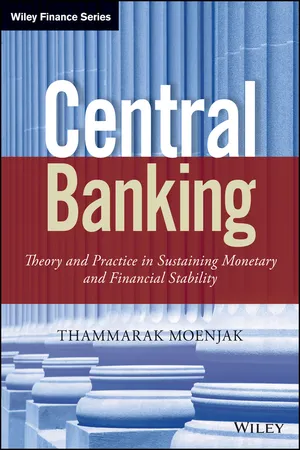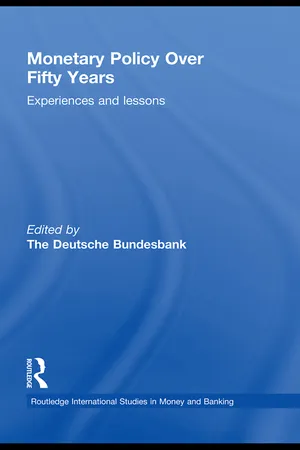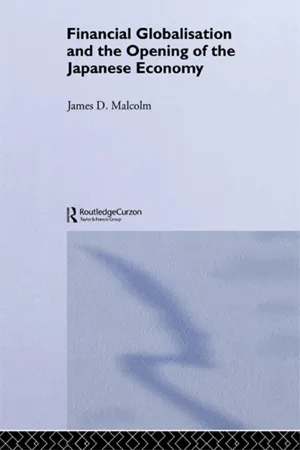Economics
Bank of Japan
The Bank of Japan is the central bank of Japan, responsible for issuing and controlling the country's currency, implementing monetary policy, and ensuring the stability of the financial system. It plays a crucial role in regulating the Japanese economy, managing inflation, and fostering economic growth through its monetary policy decisions and interventions in the financial markets.
Written by Perlego with AI-assistance
Related key terms
7 Key excerpts on "Bank of Japan"
- eBook - ePub
Role Of Central Banks In Financial Stability, The: How Has It Changed?
How Has It Changed?
- Douglas D Evanoff, Cornelia Holthausen, George G Kaufman, Manfred Kremer(Authors)
- 2013(Publication Date)
- WSPC(Publisher)
Section 6 , the paper concludes by deriving general lessons from the experience in Japan on the role of central banks in maintaining financial stability.2. Financial Instability in the 1920sThe Bank of Japan (BOJ) was established as the central bank in 1882. The bank was organized as a joint stock company, but it was tightly controlled by the government. The shareholders were limited to Japanese citizens, and they had to be approved by the Ministry of Finance before they could buy shares of the BOJ. The government was to monitor the business of the BOJ and had the power to prohibit not only the actions that violated the Bank of Japan Act or the charter, but also anything that was considered to be detrimental to the government’s interest. Under this heavy influence of the government, the BOJ often provided funds to private sector banks and industrial firms directly in the name of maintaining financial stability.The first systematic rescue loans by the BOJ happened in the post-war recession of 1920. Japanese industries expanded very rapidly during World War I, and suffered from over-extension when the war ended. In the spring of 1920, crashes in stock and commodity markets led to a financial crisis. Many banks were rumored to be in trouble and the depositors ran to their branches. From April to July 1920, there were 169 bank runs in total (BOJ, 1958, pp. 547–548). To respond to the crisis, the BOJ took several measures. First, the BOJ provided liquidity to the banking sector. For those banks that already had accounts at the BOJ, the BOJ increased the lending by relaxing the collateral requirements. In some cases, the BOJ extended loans without any collateral. The BOJ also extended credits to those banks that did not have prior transactions with the BOJ through purchase of government bonds that the banks held with repurchase agreements. - eBook - ePub
Elements of the Euro Area
Integrating Financial Markets
- Mauro Grande, Jesper Berg, Francesco Paolo Mongelli(Authors)
- 2018(Publication Date)
- Routledge(Publisher)
As regards the implementation stage, the Bank of Japan carries out its business operations through its head office in Tokyo, 33 branches (B), 13 local offices (LOs) and several overseas representative offices. The Financial Markets Department at the head office conducts daily market operations and intervenes in the foreign exchange markets. The tasks of the domestic branches include the conduct of (1) business operations relating to currency issue and (2) banking operations such as discounting of bills, extension of loans, purchases and sales of bills and services related to deposit accounts, treasury funds and Japanese government bonds. The local offices handle some of the business operations of the head office or branches.In addition to the monetary policy function, all three central banks perform other functions and tasks (see Table 2.1 for details). Several are common to all three central banks, including the issuance of banknotes, the operation of the payment system, the collection of statistical information and the holding of foreign exchange reserves. These functions are clearly of crucial importance for monetary policy and thus are, in practice, often assigned to the monetary authorities.Figure 2.5 The Bank of JapanSource: Bank of Japan (www.boj.or.jp ).The assignment of some other functions and tasks varies considerably across the three central banks. This is due, amongst others, to diverse factors that are not addressed here. One of these tasks worth mentioning is the responsibility for banking supervision and financial stability. Although the tasks of examination of depository institutions are delegated to the twelve Federal Reserve Banks, the determination of the general bank supervision policy is performed by the Federal Reserve Board in a centralized manner. In the euro area, instead, only some national central banks are involved in national supervision policies. The Bank of Japan supervises banks on a contractual basis. In order to receive emergency liquidity assistance, banks must provide the BoJ with regular information about their balance sheet and the BoJ can inspect them. The formal supervision of banks for financial stability purposes is carried out by the supervisory agency. - eBook - ePub
Central Banking
Theory and Practice in Sustaining Monetary and Financial Stability
- Thammarak Moenjak(Author)
- 2014(Publication Date)
- Wiley(Publisher)
Financial stability is important for at least three reasons. First, financial stability is needed to ensure efficient allocation of funds within the economy. A smooth functioning of the financial system is needed in order to channel excess funds from savers to borrowers efficiently. Second, in the long run, financial stability is inextricably intertwined with monetary stability. An economy facing financial instability can slip into a deflationary spiral, as happened during the Great Depression in the 1930s and has been true of the Japanese experience from the 1990s through the first decade of the twenty-first century. Third, traditional central banking functions such as payment systems oversight and supervision, lender of last resort, and banking supervision already have financial stability aspects embedded in them.The attention on the financial stability mandate began to take hold in the 1980s as frequent financial crises in both advanced and emerging market economies brought large economic costs.22 Since then, two episodes of financial instability in major advanced economies have reaffirmed the need for central banks to seriously focus on their financial stability mandate: (1) the bursting of the Japanese real estate and stock bubbles in the early 1990s that tipped Japan’s economy into deflation for more than two decades, and (2) the global financial crisis of 2007–2010.In the case of Japan, when massive real estate and stock market bubbles burst in the early 1990s, banks took a large hit and the country later fell into a period of long and painful deflation, during which prices of goods and services fell for many consecutive years.23 Postmortem analyses suggested that the central Bank of Japan had allowed money conditions to be too loose, allowing massive bubbles to arise.24 At the time, however, the Bank of Japan was willing to run a loose monetary policy because inflation appeared to be low enough.25 As events turned out, financial instability later turned into monetary instability and Japan fell into what became known as the Japanese lost decades, during which the economy struggled unsuccessfully to climb out of a deflationary spiral for over 20 years.If anything, the global financial crisis of 2007–2010 also confirmed that letting asset price bubbles to grow unchecked (in this case housing price bubbles in the United States and in Europe) can result in financial instability that can be very costly to society.26 With the Japanese experience and the global financial crisis of 2007–2010 fresh in mind, central banks are starting to take a more proactive role in the maintenance of financial stability. As bank regulators and supervisors, central banks now monitor risk exposures of banks from a more forward-looking perspective, and focus more on the interlinkages among banks as well as other institutions and players.27 - eBook - ePub
- Toichiro Asada(Author)
- 2014(Publication Date)
- Routledge(Publisher)
Shukan Toyo Keizai , December 12, pp. 114–117 (in Japanese).Ueda, K. (1999) “Remarks,” at the Fed Conference on “Monetary Policy in a Low-Inflation Environment,” in Woodstock, Vermont on October 20.White, W. (2006) “Is price stability enough?” BIS Working Papers No. 205.Passage contains an image
5 Is there any cultural difference in economics?
Keynesianism and monetarism in Japan1Masazumi Wakatabe1 Introduction: culture and economics
The current economic and financial crisis has provided us with an ample opportunity to reconsider our way of thinking about the economy and economics. One prominent feature of the current crisis was more or less the same set of policy responses: governments and central banks engaged in an expansionary fiscal and monetary policy mix. However, there was also a certain variation in policy responses: the US and the UK were more aggressive in their response, while the Euro-area and Japan were less so. The Bank of Japan (BOJ) did not increase its balance sheet as much as the Federal Reserve Board (FRB), Bank of England (BOE), or European Central Bank (ECB) (Figure 5.1 ), so that the yen appreciated against the US dollar and the euro (Figure 5.2 ), which led to the severe plunge in industrial production (Figure 5.3 ).2Figure 5.1 Changes in balance sheets of central banks (source: HP of central banks).Figure 5.2 Changes in real effective exchange rate (source: BIS Statistics).Needless to say, these policy responses are constrained as much, or even more, by political and institutional factors as by economic ideas: in the case of the Eurozone, monetary policy is conducted by the European Central Bank and constrained within the single currency euro. In the case of Japan, the government was and still is divided, with the opposition parties holding the majority of one of two diets, and there is no inflation-targeting framework despite the independence of the Bank of Japan. But there is also a concern among policy makers and even economists for inflationary policy even in the midst of deflation. - eBook - ePub
Central Bank Policy
Theory and Practice
- Perry Warjiyo, Solikin M. Juhro(Authors)
- 2019(Publication Date)
- Emerald Publishing Limited(Publisher)
Third , the central bank is a source of liquidity in the financial system and economy through monetary policy and the LOLR function, and the availability of liquidity is crucial when maintaining financial stability.2.3.4. Payment Systemic Stability
Printing and circulating currency have been the overarching purposes of the central bank since the beginning (Roberts & Velde, 2014) and, therefore, have become the basis of central bank duties in terms of monetary policy, the payment system, and financial system stability (Blinder, 2010; Goodhart, 2010). In the payment system, the central bank does not merely print currency as legal tender but also holds the accounts of the banking sector as final settlement assets for all their financial transactions, often referred to as currency outside bank or central bank money. Meanwhile, commercial banks create demand deposits by opening savings deposits for the public, otherwise known as inside money or commercial bank money. Both types of money have developed simultaneously in modern economic transactions, where public transactions are facilitated by commercial bank money and then interbank transactions are facilitated by central bank money (BIS, 2003). Confidence in commercial bank money lies in the respective commercial bank’s ability to liquidate term deposits and other obligations to the public as required from the liquid assets held, or through financial transactions with other commercial banks and/or through their account held at the central bank. On the other hand, confidence in central bank money lies in the central bank’s ability to provide liquidity to commercial banks as required and maintain a stable value of the money created, namely price and exchange rate stability. - eBook - ePub
- Heinz Herrmann(Author)
- 2009(Publication Date)
- Routledge(Publisher)
Under the new Bank of Japan law, a governor and two deputy governors are appointed for the term of five years and firing any of them by the government during their term is impossible. In addition, six members are appointed to the Monetary Policy Board, which was revamped in organization. Their status is also protected by law. Although two government representatives attend the monetary policy meetings, they cannot vote in the monetary policy decision.Legal mandates and inflation targeting
One of the major changes in the history of central banking occurred in the 1990s when New Zealand adopted inflation targeting. The Reserve Bank of New Zealand announced the target inflation rate based on the accord with the Treasury, and guided the policy to achieve the target. If the target is missed by a wide margin (i.e. more than plus or minus 1 per cent), the Governor is held accountable. The accord made it clear that the first priority of the central bank is price stability.The new Bank of Japan law was enacted in April 1998. In addition to independence, the Bank of Japan obtained the single mandate, price stability. The Bank of Japan on one hand rejects inflation targeting, but on the other hand started to announce inflation ‘forecasts’ of nine Board Members. The Bank of Japan is careful to emphasize that forecasts are not targets.1Fight against deflation
The very adverse environment occurred in 1997 to 1998. Several banks failed and a severe credit crunch occurred. The growth rate in 1998 was negative, and prices started to fall. No concrete action was taken until February 1999, when the zero interest rate policy was essentially employed. The call rate was brought down to zero in the following weeks, and this was only a beginning. However, the economy became slightly better in the first half of 1999, so that the Bank of Japan raised the interest rate from zero to 0.25 per cent in August 2000. Two dissenting votes were cast in the decision to end the zero interest rate policy.The economy worsened again towards the end of 2000. The Bank of Japan eased in March 2001, again lowering the interest rate to zero, but with an additional measure, Quantitative Easing (QE). This guaranteed to have more liquidity in the market than before. The Bank increased the purchase of long-term government bonds as a part of making sure that liquidity is provided. In March 2006, QE ended, and ZIRP reinstated. In July 2006, the first rate hike since August 2000 was implemented. - James P. Malcolm(Author)
- 2013(Publication Date)
- Routledge(Publisher)
In 1975, the BOJ found that it could no longer reabsorb, for fear of fueling inflation, the proportion of the outstanding bonds held by banks that it customarily repurchased prior to maturity. 33 Banks were thus left holding large quantities of the low-yielding bonds until maturity, and in protest, boycotted subsequent placement syndicates on a number of occasions. This forced the MOF to begin deregulating the bond market; politicians were powerless to intervene, having initiated the new spending commitments in the first place. 34 Critically, because rates in the JGB market acted as an anchor to all others, scrapping the artificially low interest rates in this sector immediately put pressure on, or demolished outright, the rigid structures which were in place elsewhere. (ii) International Developments: Early Attempts to Manage Monetary Instability A second front on which Japan’s financial authorities came under pressure to reform their regime was through the country’s newfound involvement in international economic diplomacy in the 1970s. 35 This pressure was indirect but again related to the fact that the Japanese economy was no longer small in comparative terms – it had consolidated its position as the world’s third largest economy and was clearly no longer a price-taker in international markets. Essentially, the sympathetic international consensus towards the country’s development which the US had underwritten against the backdrop of Cold War politics rapidly waned as Japanese mercantilism became a focus of attention upon which other countries could pin many of their difficulties in the unstable macroeconomic environment. This led to calls for significant liberalisation of Japan’s markets in both trade and finance, but centred on the revaluation of the yen. Serious criticism first surfaced with the events surrounding the breakdown of Bretton Woods
Learn about this page
Index pages curate the most relevant extracts from our library of academic textbooks. They’ve been created using an in-house natural language model (NLM), each adding context and meaning to key research topics.






